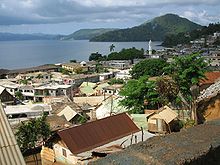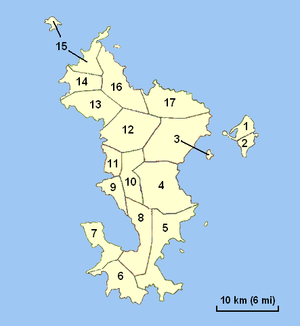Mayotte (French: Mayotte, pronounced: [majɔt]; Shimaore: Maore, IPA: [maˈore]; Malagasy: Mahori) is an overseas department and region[5] of France consisting of a main island, Grande-Terre (or Mahoré), a smaller island, Petite-Terre (or Pamanzi), and several islets around these two. The archipelago is located in the northern Mozambique Channel in the Indian Ocean, namely between northwestern Madagascar and northeastern Mozambique. Mayotte's area is 374 square kilometres (144 sq mi), and with its estimated 194,000 people is very densely populated (520 inhabitants per square kilometre [1,300 /sq mi]). Its biggest city and prefecture is Mamoudzou. The territory is geographically part of the Comoro Islands, but has been politically separate since a 1974 referendum in which it elected to remain under French rule. The territory is also known as Mahoré, the native name of its main island, especially by advocates of its inclusion in the Union of Comoros. In a 2009 referendum, the population overwhelmingly approved accession to status of department (95.2% of favorable votes). On March 31, 2011, Mayotte became an overseas department.
Contents[hide] |
[edit] Geography
The main island, Grande-Terre (or Mahoré), geologically the oldest of the Comoro Islands, is 39 kilometres (24 mi) long and 22 kilometres (14 mi) wide, and its highest point is Mount Benara, at 660 metres (2,165 ft) above sea level. Because of the volcanic rock, the soil is relatively rich in some areas. A coral reef encircling much of the island ensures protection for ships and a habitat for fish. Dzaoudzi was the capital of Mayotte until 1977. It is situated on Petite-Terre (or Pamanzi), which at 10 square kilometres (4 sq mi) is the largest of several islets adjacent to Mahoré.
[edit] History
- For the history of Mayotte before 1974 see also History of the Comoros.
In 1500 the Maore or Mawuti (contraction of the Arabic جزيرة الموت Jazīrat al-Mawt -meaning island of the dead / of death and corrupted to Mayotte in French) sultanate was established on the island. In 1503, Mayotte was observed by Portuguese explorers, but not colonized.
In 1832, it was conquered by Andriantsoly, former king of Iboina on Madagascar; in 1833 conquered by the neighbouring sultanate of Mwali (Mohéli island in French); on 19 November 1835 again conquered by the Ndzuwani Sultanate (Anjouan sultanate in French; a governor was installed with the unusual Islamic style of Qadi (from the Arabic قاض which means judge), sort of a 'Resident Magistrate' in British terms), but in 1836 regained its independence under a last local Sultan.
Mayotte was ceded to France along with the other Comoro Islands in 1843. It was the only island in the archipelago that voted in referendums in 1974[6] and 1976 to retain its link with France and forgo independence (with 63.8% and 99.4% of votes respectively). The Comoros continue to claim the island. A draft 1976 United Nations Security Council resolution recognizing Comorian sovereignty over Mayotte, supported by 11 of the 15 members of the Council, was vetoed by France.[7] It was the last time, as of 2011[update], that France cast a lone veto in the Council.[8] The United Nations General Assembly has adopted a series of resolutions on the issues, whose tenor can be gauged from their title: "Question of the Comorian Island of Mayotte" up to 1995. Since 1995, the subject of Mayotte has not been discussed by the General Assembly.
Mayotte became an overseas department of France in March 2011 in consequence of a 29 March 2009 referendum.[9] The outcome was a 95.5 per cent vote in favour of changing the island's status from a French "overseas community" to become France's 101st département.[10] Its non-official traditional Islamic law, applied in some aspects of the day-to-day life, will be gradually abolished and replaced by the uniform French civil code.[11] Additionally, French social welfare and taxes apply in Mayotte, though some of each will be brought in gradually.[12]

[edit] Politics
Politics of Mayotte takes place in a framework of a parliamentary representative democratic French overseas community, whereby the President of the General Council is the head of government, and of a multi-party system. Executive power is exercised by the government.
Mayotte also sends one deputy to the French National Assembly and two senators to the French Senate.
The situation of Mayotte proved to be awkward for France: while the local population very largely did not want to be independent from France and join the Comoros, some international criticism from post-colonial leftist regimes was heard about Mayotte's ongoing ties to France. Furthermore, the peculiar local administration of Mayotte, largely ruled by customary Muslim law, would be difficult to integrate into the legal structures of France, not to mention the costs of bringing the standards of living to levels close to those of Metropolitan France. For these reasons, the laws passed by the national parliament had to state specifically that they applied to Mayotte for them to be applicable on Mayotte.
The status of Mayotte was changed in 2001 towards one very close to the status of the departments of France, with the particular designation of departmental collectivity. This change was approved by 73% of voters in a referendum. After the constitutional reform of 2003 it became an overseas collectivity while retaining the title "departmental collectivity" of Mayotte.
Mayotte became an overseas department of France (or DOM, département d'outre-mer) on 31 March 2011 following the result of the March 2009 Mahoran status referendum, which was overwhelmingly approved by around 95% of voters.[13][14] Becoming an overseas department will mean it will adopt the same legal and social system as used in the rest of France. This will require abandoning some customary laws, adopting the standard French civil code, and reforming the judiciary, educational, social and fiscal systems, and will take place over a period of about 20 years.[citation needed] Despite its domestic constitutional evolution from the status of an overseas collectivity to that of an overseas department, Mayotte will remain an 'Overseas country and territory' (OCT) in association with the Union and will only become an outermost region of the European Union on the request of the French government, and through the process outlined in Declaration 43 annexed to the Treaty of Lisbon.
[edit] Administrative divisions
Mayotte is divided into 17 communes. There are also 19 cantons (not shown here) each of which corresponds to one of the communes, except for the commune of Mamoudzou which is divided into three cantons. There are no arrondissements.
[edit] Transport
- No railways or waterways.
- Highways:
- total: 93 kilometres (58 mi)
- paved : 72 kilometres (45 mi)
- unpaved : 21 kilometres (13 mi)
- total: 93 kilometres (58 mi)
- Ports and harbours:
- Dzaoudzi
- "Longoni" (Koungou)
- Airports: Dzaoudzi Pamandzi International Airport - the only airport in Mayotte
- with paved runways: 1 (2002)
[edit] Economy
The official currency of Mayotte is the euro.[15]
In 2005 the GDP of Mayotte at market exchange rates was US$1.13 billion (€0.91 billion).[4] In that same year the GDP per capita of Mayotte at market exchange rates, not at PPP, was US$6,500 (€5,200),[4] which was 10 times higher than the GDP per capita of the Comoros that year, but only a third of the GDP per capita of Réunion and 19% of the GDP per capita of Metropolitan France.[4]
[edit] Demographics
| 1958 | 1966 | 1978 | 1985 | 1991 | 1997 | 2002 | 2007 | |||||
|---|---|---|---|---|---|---|---|---|---|---|---|---|
| 23,364 | 32,607 | 47,246 | 67,205 | 94,410 | 131,320 | 160,265 | 186,452 | |||||
| Official population figures from past censuses. | ||||||||||||
As of the July 2007 census there were 186,452 people living in Mayotte.[3] According to the 2002 census, 64.7% of the people living in Mayotte were born in Mayotte, 3.9% were born in the rest of the French Republic (either metropolitan France or overseas France except Mayotte), 28.1% were immigrants from the Comoros, 2.8% were immigrants from Madagascar, and the remaining 0.5% came from other countries.[16]
[edit] Religion

The main religion in Mayotte is Islam,[17] with 97% of the population Muslim and 3% Christian.[6] 85,000 of the total 90,000 inhabitants of the island are Comorians. The Comorians are a blend of settlers from many areas: Iranian traders, mainland Africans, Arabs and Malagasy. Comorian communities can also be found in other parts of the Comoros chain as well as in Madagascar.
[edit] Languages
| This section may contain inappropriate or misinterpreted citations that do not verify the text. Please help improve this article by checking for inaccuracies. (help, talk, get involved!) (March 2009) |
French is the only official language of Mayotte. It is the language used for administration and the school system. It is the language most used on television and radio as well as in commercial announcements and billboards. In spite of this, Mayotte is one of the French overseas territories where the knowledge of French is the least developed, as shown by the figures above. At the 2002 census, only 55% of people older than 15 declared they could read and write French, although this figure is higher than those who can read and write Shimaore (41%) or Arabic (33%).
With the mandatory schooling of children and the economic development both implemented by the French central state, the French language has progressed significantly on Mayotte in recent years. The survey conducted by the Ministry of National Education showed that while first and second language speakers of French represented 56.9% of the population in general, this figure was only 37.7% for the parents of CM2 pupils, but reached 97.0% for the CM2 pupils themselves (whose age is between 10 and 14 in general).
Nowadays there are instances of families speaking only French to their children in the hope of helping their social advancement. With French schooling and French language television, many young people turn to French or use many French words when speaking Shimaore and Kibushi, leading some to fear that these native languages of Mayotte could either disappear or become some sort of French-based creole.[18]
The native languages of Mayotte are:
- Shimaore, a Swahili dialect heavily influenced by French and Malagasy
- Kibushi, a western dialect of the Malagasy language (the language of Madagascar) heavily influenced by Shimaore and Arabic
- Kiantalaotsi, another western dialect of the Malagasy language also heavily influenced by Shimaore and Arabic
Kibushi is spoken in the south and north-west of Mayotte, while Shimaore is spoken elsewhere.
Arabic is taught in the Quranic schools. Various dialects of the Comorian language essentially imported by immigrants who have arrived in Mayotte since 1974: Shindzwani (the dialect of Anjouan, or Nzwani), Shingazidja (the dialect of Grande Comore, or Ngazidja), and Shimwali (the dialect of Mohéli, or Mwali).
A survey was conducted by the French Ministry of National Education in 2006 among pupils registered in CM2 (equivalent to fifth grade in the US and Year 6 in England and Wales). Questions were asked regarding the languages spoken by the pupils as well as the languages spoken by their parents. According to the survey, the ranking of mother tongues is the following (ranked by number of first language speakers in the total population; note that percentages add up to more than 100% because some people are natively bilingual):[19]
- Shimaore: 55.1%
- Shindzwani: 22.3%
- Kibushi: 13.6%
- Shingazidja: 7.9%
- French: 1.4%
- Shimwali: 0.8%
- Arabic: 0.4%
- Kiantalaotsi: 0.2%
- Other: 0.4%
However, when also counting second language speakers (e.g. someone whose mother tongue is Shimaore but who also speaks French as a second language) then the ranking becomes:
- Shimaore: 88.3%
- French: 56.9%
- Shindzwani: 35.2%
- Kibushi: 28.8%
- Shingazidja: 13.9%
- Arabic: 10.8%
- Shimwali: 2.6%
- Kiantalaotsi: 0.9%
- Other: 1.2%





No comments:
Post a Comment